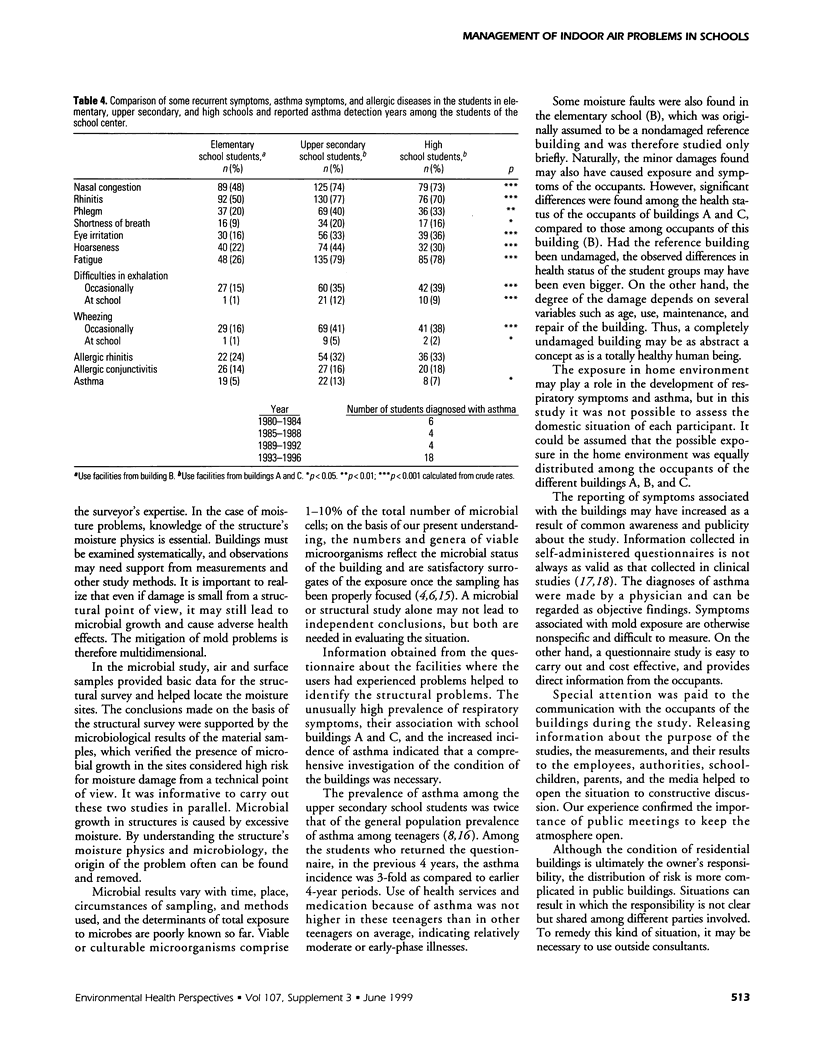Abstract
This study was conducted in a school center that had been the focus of intense public concern over 2 years because of suspected mold and health problems. Because several attempts to find solutions to the problem within the community were not satisfactory, outside specialists were needed for support in solving the problem. The study group consisted of experts in civil engineering, indoor mycology, and epidemiology. The studies were conducted in close cooperation with the city administration. Structures at risk were opened, moisture and temperature were measured, and the causes of damage were analyzed. Microbial samples were taken from the air, surfaces, and materials. Health questionnaires were sent to the schoolchildren and personnel. Information on the measurements and their results was released regularly to school employees, students and their parents, and to the media. Repairs were designed on the basis of this information. Moisture damage was caused mainly by difficult moisture conditions at the building site, poor ventilation, and water leaks. Fungal genera (concentrations <200 colony-forming units (cfu)/m(3), <3000 cfu/cm(2)) typical to buildings with mold problems (e.g., Aspergillus versicolor, Eurotium) were collected from the indoor air and surfaces of the school buildings. Where moisture-prone structures were identified and visible signs of damage or elevated moisture content were recorded, the numbers of microbes also were high; thus microbial results from material samples supported the conclusions made in the structural studies. Several irritative and recurrent symptoms were common among the upper secondary and high school students. The prevalence of asthma was high (13%) among the upper secondary school students. During the last 4 years, the incidence of asthma was 3-fold that of the previous 4-year period.
Full text
PDF





Images in this article
Selected References
These references are in PubMed. This may not be the complete list of references from this article.
- Brunekreef B. Associations between questionnaire reports of home dampness and childhood respiratory symptoms. Sci Total Environ. 1992 Dec 15;127(1-2):79–89. doi: 10.1016/0048-9697(92)90471-4. [DOI] [PubMed] [Google Scholar]
- Husman T. Health effects of indoor-air microorganisms. Scand J Work Environ Health. 1996 Feb;22(1):5–13. doi: 10.5271/sjweh.103. [DOI] [PubMed] [Google Scholar]
- Pekkanen J., Remes S. T., Husman T., Lindberg M., Kajosaari M., Koivikko A., Soininen L. Prevalence of asthma symptoms in video and written questionnaires among children in four regions of Finland. Eur Respir J. 1997 Aug;10(8):1787–1794. doi: 10.1183/09031936.97.10081787. [DOI] [PubMed] [Google Scholar]
- Taskinen T., Meklin T., Nousiainen M., Husman T., Nevalainen A., Korppi M. Moisture and mould problems in schools and respiratory manifestations in schoolchildren: clinical and skin test findings. Acta Paediatr. 1997 Nov;86(11):1181–1187. doi: 10.1111/j.1651-2227.1997.tb14841.x. [DOI] [PubMed] [Google Scholar]
- Timonen K. L., Pekkanen J., Korppi M., Vahteristo M., Salonen R. O. Prevalence and characteristics of children with chronic respiratory symptoms in eastern Finland. Eur Respir J. 1995 Jul;8(7):1155–1160. doi: 10.1183/09031936.95.08071155. [DOI] [PubMed] [Google Scholar]



